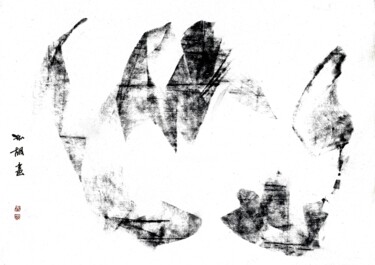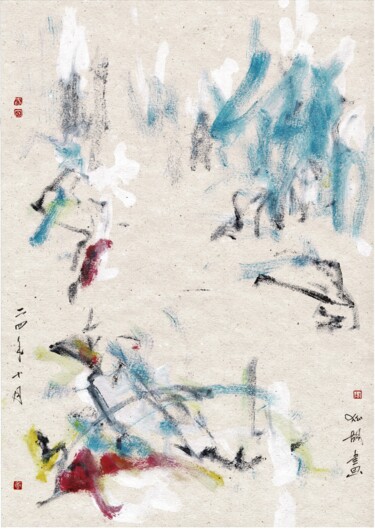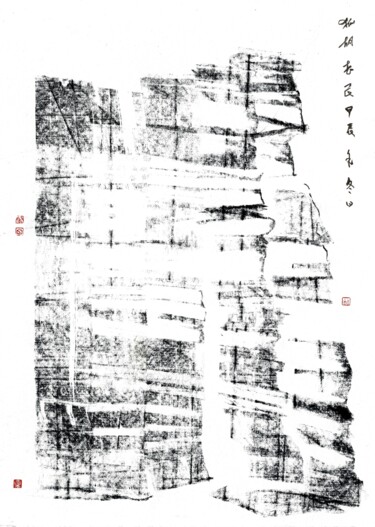Friedrich Zettl
Friedrich Zettl, an Austrian artist, creates captivating paintings, graphic art, and calligraphy that seamlessly blend Western and Eastern aesthetics.
His artistic journey began with Western painting, but a profound passion for Chinese culture and art led him to explore new horizons.
Education and Artistic Development
From 1978 to 1985, Zettl studied Sinology and Chinese painting at the prestigious Central Academy of Fine Arts in Beijing. During this period, he wrote his dissertation on a specific aspect of Chinese painting, deepening his knowledge and practice of this ancient art form. Before his immersion in Chinese art, Zettl exhibited his expressionist oil paintings across Europe. However, his exposure to traditional Chinese painting techniques and philosophy transformed his artistic approach, infusing his work with Asian thinking and aesthetics.
Artistic Style and Techniques
Zettl's art is characterized by its unique fusion of Western and Eastern elements. His brushwork and compositions are heavily influenced by the techniques and philosophy of Chinese calligraphy. Primarily working on paper, he employs fine inks and has developed his own techniques that blend Western media with Asian concepts in innovative ways.
Exhibitions and PublicationsFriedrich Zettl has showcased his art in numerous solo and group exhibitions across Europe, Asia, and South America. He has also contributed to several books on Chinese art. His works are a testament to his versatility and ability to bridge cultural divides through art.
Artistic Vision
Living and working in Vienna, Friedrich Zettl continues to seek new inspirations and challenges. His art serves as a bridge between the Western and Eastern worlds, showcasing a harmonious blend of diverse cultural influences. Through his innovative and versatile approach, Zettl remains a dynamic and influential figure in the art world.
Discover contemporary artworks by Friedrich Zettl, browse recent artworks and buy online. Categories: contemporary austrian artists. Artistic domains: Drawing, Painting. Account type: Artist , member since 2022 (Country of origin Austria). Buy Friedrich Zettl's latest works on ArtMajeur: Discover great art by contemporary artist Friedrich Zettl. Browse artworks, buy original art or high end prints.

Artist Value, Biography, Artist's studio:
Latest Artworks by Friedrich Zettl • 38 artworks
View allAbstract Surrealism • 42 artworks
View allUnleash your imagination and explore the captivating world of "Abstract Surrealism." This collection features a stunning array of artworks that blend abstract forms with dreamlike imagery. Explore unexpected juxtapositions, thought-provoking symbolism, and evocative compositions that challenge your perception of reality. Discover a new dimension of art where the subconscious takes center stage.
Gestural and Informal Painting • 31 artworks
View allZen Paintings - Silence in Color • 40 artworks
View allImmerse yourself in the world of Zen with our captivating collection of "Zen Paintings - Silence in Color." Explore a stunning array of abstract landscapes that evoke a sense of tranquility and inner peace. Each piece masterfully blends minimalist aesthetics with vibrant colors, reflecting the core principles of Zen philosophy. Discover the beauty of simplicity and embark on a meditative journey through these evocative artworks.
Painted Haiku • 11 artworks
View allIn this series, each painted Haiku serves as a fusion of image and verse, where words and brushstrokes create a meditative dialogue. The minimalist nature of haiku poetry aligns closely with Zen ideas, emphasizing mindfulness, emptiness, and a focus on the present moment. Likewise, the artwork reflects these values through subtle compositions and refined brushwork, inviting the viewer to explore the quiet beauty in each scene.
Though Zettl’s haiku may not strictly follow the classical structure, they maintain the spirit of haiku by capturing fleeting moments of natural beauty and profound insight. This approach allows the series to form a harmonious connection between Eastern philosophy, poetry, and visual expression, offering viewers a contemplative experience.
Explore the Painted Haiku Series and discover how the fusion of haiku poetry and Zen-inspired painting opens a gateway to stillness, simplicity, and reflection.
Calligraphy and Asemic Painting • 17 artworks
View allStudies - Sketches- Smalls • 21 artworks
View allDigital Artwork • 9 artworks
View allExplore a diverse range of themes and styles, all rendered with precision and a unique artistic vision. Ideal for modern art enthusiasts, these digital artworks offer a fresh perspective on the fusion of art and technology.
Sold Artworks • 1 artwork
Recognition
The artist has won prizes and awards
The artist has been published in the media, radio or TV press
The artist's works have been noticed by the editorial staff
The artist participates in art shows and fairs
Exercises the profession of artist as a main activity
Biography
Friedrich Zettl, an Austrian artist, creates captivating paintings, graphic art, and calligraphy that seamlessly blend Western and Eastern aesthetics.
His artistic journey began with Western painting, but a profound passion for Chinese culture and art led him to explore new horizons.
Education and Artistic Development
From 1978 to 1985, Zettl studied Sinology and Chinese painting at the prestigious Central Academy of Fine Arts in Beijing. During this period, he wrote his dissertation on a specific aspect of Chinese painting, deepening his knowledge and practice of this ancient art form. Before his immersion in Chinese art, Zettl exhibited his expressionist oil paintings across Europe. However, his exposure to traditional Chinese painting techniques and philosophy transformed his artistic approach, infusing his work with Asian thinking and aesthetics.
Artistic Style and Techniques
Zettl's art is characterized by its unique fusion of Western and Eastern elements. His brushwork and compositions are heavily influenced by the techniques and philosophy of Chinese calligraphy. Primarily working on paper, he employs fine inks and has developed his own techniques that blend Western media with Asian concepts in innovative ways.
Exhibitions and PublicationsFriedrich Zettl has showcased his art in numerous solo and group exhibitions across Europe, Asia, and South America. He has also contributed to several books on Chinese art. His works are a testament to his versatility and ability to bridge cultural divides through art.
Artistic Vision
Living and working in Vienna, Friedrich Zettl continues to seek new inspirations and challenges. His art serves as a bridge between the Western and Eastern worlds, showcasing a harmonious blend of diverse cultural influences. Through his innovative and versatile approach, Zettl remains a dynamic and influential figure in the art world.
-
Nationality:
AUSTRIA

- Date of birth : 1954
- Artistic domains: Works by artists with a certified artist value, Works by professional artists,
- Groups: Certified Artists Professional Artist Contemporary Austrian Artists
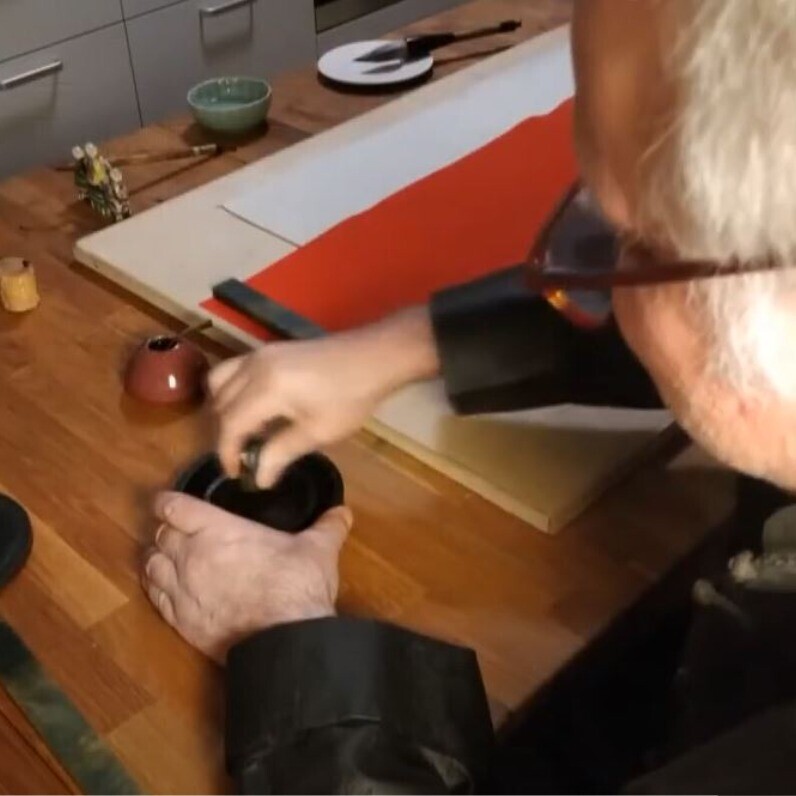
Ongoing and Upcoming art events
Influences
Education
Artist value certified
Certification established in collaboration with Akoun, the world leader in art market information since 1985.

Artist Value Painting 2023 | €1,100.00 ($1,281.28)
Certification has been established by Jacques-Armand Akoun on Oct 30, 2023.
Achievements
Collective Expositions
Publications & Press
Solo Expositions
Activity on ArtMajeur
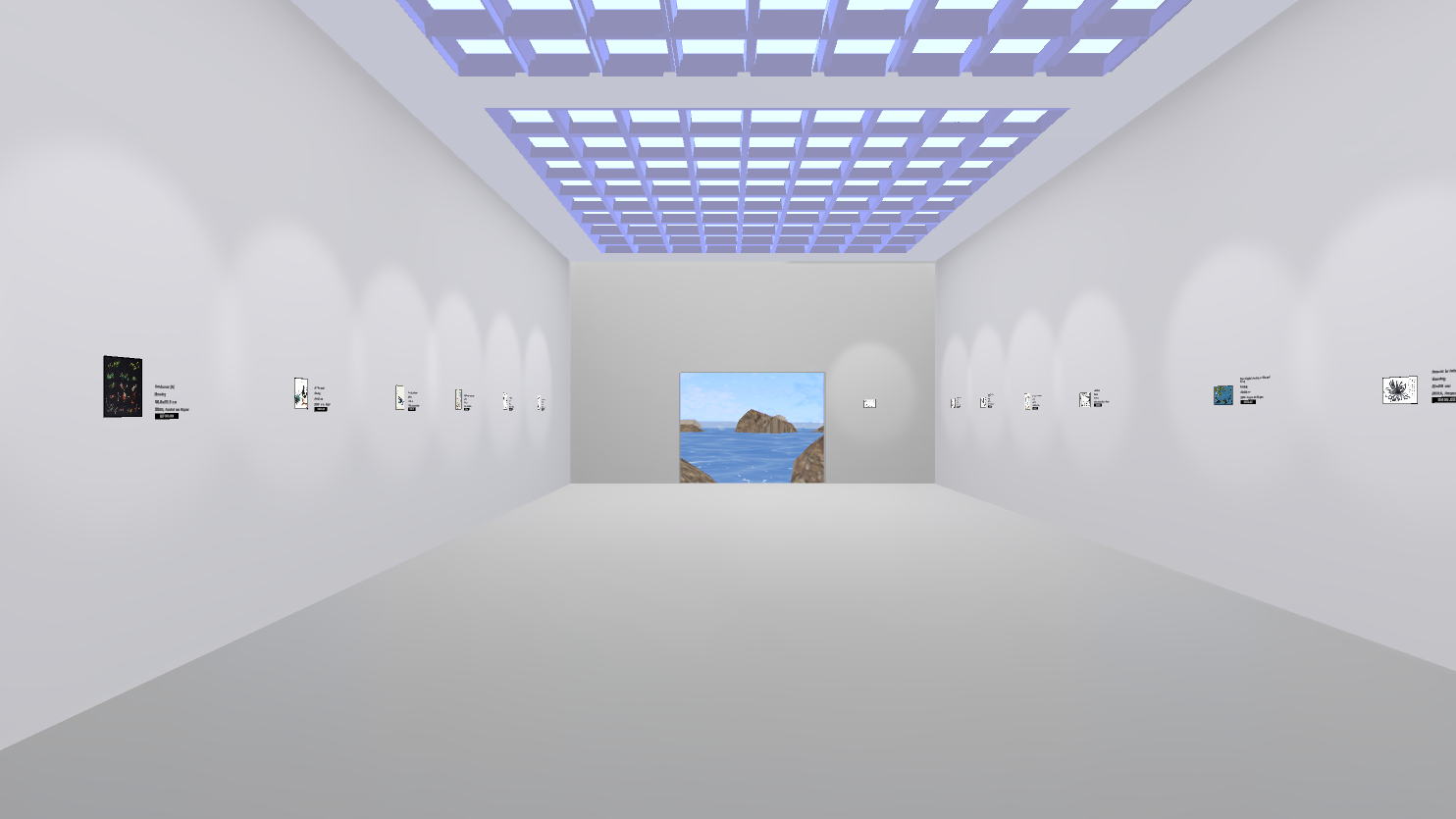
Latest News
All the latest news from contemporary artist Friedrich Zettl
TV Portrait of Austrian Artist Friedrich Zettl
This feature on Friedrich Zettl, an Austrian artist, was broadcast on Chinese television and as part of the Tandem series on okto.tv. You can watch the full program in the Oktothek: https://okto.tv/de/oktothek/episode/64707ff5b2eea.
In the interview, Zettl discusses his approach to painting, his artistic concepts, and his time at the Central Academy of Fine Arts in Beijing, where he studied traditional Chinese painting, calligraphy, and seal carving. His unique style merges Asian philosophies with modern Western influences, resulting in a distinctive and personal artistic expression.
For more insights into Chinese art and regular updates on Zettl’s work, visit his blog at: zettl.blog.
Exploring the Void: My Artistic Journey into "Nothingness in Color"
Welcome, art enthusiasts, to an intimate look at my latest significant body of work: the "Nothingness in Color" series. This collection represents a profound evolution in my artistic practice, stemming from years of exploring the essence of form and meaning through a minimalist lens.
The Genesis of Nothingness: From Monochrome to Chromatic Depth
My artistic journey began with a deep immersion in monochrome, a deliberate stripping away of all but the most fundamental elements. This foundation laid the groundwork for the "Nothingness in Color" series, which courageously, yet gradually, embraced the spectrum. At its core, my minimalist approach remains steadfast, deeply interwoven with the timeless philosophies of Zen painting and Daoism. These ancient wisdoms continue to guide my hand, reminding me that profound meaning can reside in simplicity, and that the void itself is a fertile ground for creation.
The Art of Omission and the Paradox of Presence
In "Nothingness in Color," I returned to the challenging principle of omission. It’s an intriguing paradox: how do you remove elements when there's already so little left? Yet, within this extreme reduction, the absolute essential—the very heartbeat of my artistic signature—emerges: contrasts. This series is a testament to the powerful interplay of opposing forces, a dance of:
Movement and Stillness
Power and Softness
Darkness and Light
While these paintings might appear deceptively simple, their creation is often profoundly challenging. My process involves navigating numerous pitfalls: avoiding the merely "pleasing," resisting cheap effects, and striving to impress through nuanced color alone. My constant goal is to blur the line between the concrete and the abstract, to discover that delicate balance where the work resonates most authentically. This continuous search often feels like a precarious balancing act, but it's precisely where the true essence of the work takes form.

Echoes of Emptiness, Whispers of Light
From the "Nothingness in Color" series, this piece embodies a minimalist dialogue between presence and absence. Luminous strokes of blue, green, and subtle gold emerge from the deep void, akin to "whispers of light" animating the "echoes of emptiness." Inspired by Zen and Daoist principles, it explores the profound interplay of light and shadow, inviting contemplation on the dynamic contrasts that define existence.
Adding to "Nothingness": The Creative Imperative
As artists practicing omission, we inevitably reach a limit—a zenith, much like in life itself. When we choose to leave something out, we must then fill the resulting "emptiness" with something else. This could be a single ray of light, a splash of color, or a precise line. Crucially, these additions must always remain subservient to the overarching concept of nothingness, enhancing it rather than overwhelming it.
In this next phase, I consciously chose to add rather than solely omit. This presents a unique challenge: how to introduce more elements without compromising the fundamental idea of nothingness, or losing the dynamic flow and the essential interplay of opposing poles.
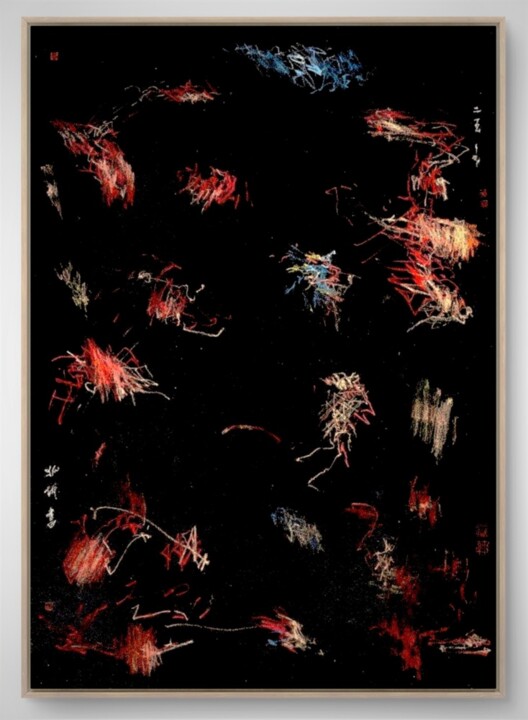
Meditations on Absence
This piece from the "Nothingness in Color" series delves into the profound concept of absence, a core tenet of Zen and Daoist philosophy. Against a vast, dark ground, fragmented bursts of color – primarily vibrant reds and blues – appear as fleeting thoughts or echoes. Each luminous mark serves as a point of contemplation, inviting the viewer to meditate on the power of the unsaid, the unseen, and the dynamic tension between the void and the brief, energetic moments of presence.
Diving Deeper: Microcosm, Macrocosm, and Musical Resonance
The painting "Essence of Flow" directly addresses this challenge of adding while preserving the core. It strives to embody this claim while also introducing the concept of microcosm versus macrocosm, hinting at the spherical nature of these unseen forces within the minimalist field.
My piece, "Flickers of Being," was originally conceived as the singular "State of the Art 2025." However, its subtleties don't always translate effectively on screen, prompting the decision to present the entire series instead. My intention for each of these "flickers" was to imbue them with meaning, without being overly specific. More importantly, I aimed to create a dialogue between all the individual elements—a constant endeavor in my work. This painting, like others in the series, carries a strong affinity with the music of Anton von Webern, whose post-romantic, minimalist approach deeply resonates with my artistic heart.
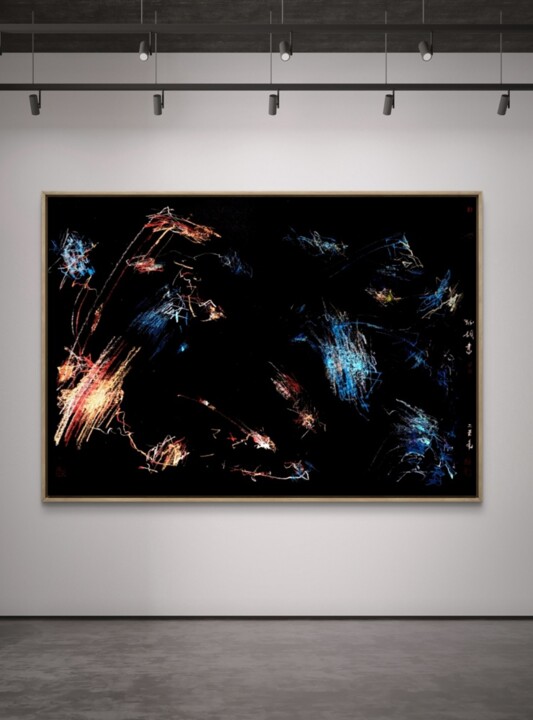
Whispers of Genesis
Part of the "Nothingness in Color" series, "Whispers of Genesis" explores the profound moment of creation emerging from the void, echoing the tenets of Daoist philosophy. Dynamic lines and luminous colors — notably blues, reds, and golden earth tones — subtly coalesce against the deep black, suggesting nascent forms and directional energy. This painting captures the delicate balance between the formless and the emergent, portraying a quiet, elemental beginning where presence softly unfurls from absence.
Embracing the Full Spectrum: The Challenge of "Heart of the Silence"
"Heart of the Silence" takes this exploration a step further, opening up to a full color palette. It's often simpler to achieve a harmonious expression when working with fewer colors. Each additional color, however, introduces a new layer of "excitement," making the pursuit of meditative expression, tranquility, and a sense of the eternal considerably more difficult. Yet, this challenge is precisely where the deeper conversation of "Nothingness in Color" truly begins.

Heart of the Silence
From the "Nothingness in Color" series, "Heart of the Silence" delves into the profound quietude that can emerge even within a full chromatic palette. Here, vibrant hues, anchored by a commanding red presence, bloom against the deep black, defying the inherent "excitement" of a broader spectrum. This piece embodies the challenge of achieving meditative expression and tranquility amidst increased complexity, revealing the harmonious and eternal core within the dynamic interplay of color and the infinite void.
My Artistic Signature: What Makes "Nothingness in Color" Unique
Even a president finds reason to praise himself, so as an artist, I feel entitled to share why I believe this "State of the Art 2025" series truly represents a pinnacle in my work.
Firstly, I've dedicated myself to developing a distinct style and, indeed, my own unique technique. Many artists spend their entire careers striving for a recognizable artistic signature—creating works immediately attributable to them. This pursuit is as challenging in visual art as it is in any other creative discipline.
Furthermore, this current series seamlessly integrates with my work from recent years. Its foundational ideas remain consistent, rooted deeply in Daoist and Zen philosophies. While simply replicating the Old Masters holds little purpose, I find it essential to cultivate these profound philosophical concepts and reinterpret them within a contemporary context. For instance, modern quantum physics, with its confirmation of entanglement, echoes principles Zen embraced over a century ago. In my painting, I strive to incorporate this aspect of interconnectedness—the entanglement of lines, dots, and forms.
This endeavor has led me to forge a style that masterfully blends Western and Far Eastern artistic ideas. Far fewer painters achieve this synthesis than one might imagine. Many still recall the groundbreaking collaboration between Ravi Shankar and Yehudi Menuhin; their "West Meets East" album remains a musical milestone, a parallel to the artistic bridge I aim to build.
I could continue this list, but that's quite enough self-congratulation :)
In the Blind Drawing series, nudes are captured through a unique, unfiltered process: drawing in complete darkness, relying solely on touch and intuition. By removing sight, I bypass traditional techniques and tap into a deeper connection with the figure. This creates an expressive and fragmented view, pushing the boundaries of form and perception. The medium is minimal: black pen for lines, accented with felt-tip for depth. These bold strokes showcase the rawness of the process, emphasizing immediacy and structure.
Explore Wabi-Sabi Through My Art
Welcome to a visual journey into Wabi-Sabi. This deep philosophy from Zen and Japanese culture values imperfection, impermanence, and life's natural cycles.
My paintings embody Wabi-Sabi by embracing simplicity and the beauty of the incomplete. Each brushstroke captures the passage of time and graceful aging, reminding us of life's fleeting nature. Muted tones and textures evoke stillness, inviting reflection.
Zen painting parallels Wabi-Sabi's minimalist approach, suggesting the unseen and leaving space for contemplation. Rough edges and soft transitions reveal the raw, authentic beauty in nature and daily life.
Through my art, I convey peaceful acceptance of life's stages—whether blossoming or decaying—finding harmony in every moment. Thank you for joining me on this exploration of Wabi-Sabi and Zen painting. I hope these images offer reflection and calm in a fast-paced world.
The Influence of Music on My Painting
Music and Painting
Music plays a significant role in my artistic process, alongside the philosophical concepts of Daoism and Zen Buddhism that deeply influence my work. While the music I listen to while painting can set the tone for a piece, it is often the underlying structure and ideas within the music that shape my creative expression.
Johann Sebastian Bach holds a special place in my heart, and his work has a profound influence on my painting. I find particular inspiration in Glenn Gould's interpretation of Bach. Gould’s approach—deconstructing Bach’s compositions, meticulously exploring their individual parts, and then reassembling them—parallels my own process in visual art. This idea of breaking down and reconstructing elements resonates with the way I approach my brushwork and composition.

Bach's influence on my art [offer]
Another strong influence on my art is the contemporary composer Arvo Pärt. His minimalist, deeply spiritual music often inspires me to explore visual translations of his work. One piece that has particularly influenced me is Pärt’s "Spiegel im Spiegel" (Mirror in the Mirror). The simplicity and repetition in the music mirror the meditative nature of my creative process, and I have worked to visually capture the emotional depth of his compositions.
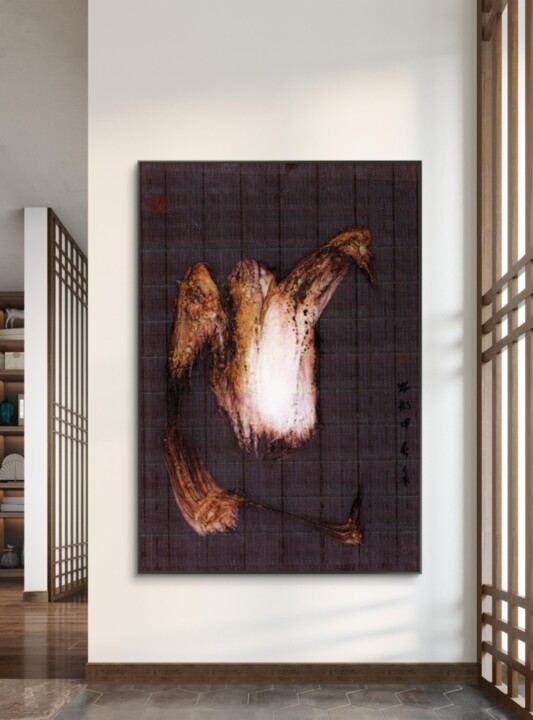
Arvo Pärt "Mirror in the Mirror" [offer]
Brian Eno and his ambient music have also shaped my artistic journey. His album "My Life in the Bush of Ghosts" serves as a direct source of inspiration, with its innovative use of sound layering influencing the textures and layers in my paintings. The concept of ambient music—creating an atmosphere rather than a linear progression—reflects my approach to creating art that invites contemplation and immersion.

Brian Eno and David Byrne "My Life in the Bush of Ghosts" [offer]
Music, for me, is not merely a background element but a conceptual tool that informs the rhythm, structure, and emotional tone of my work. Through this interplay between sound and visual art, I seek to create pieces that evoke a deeper connection and meditative experience for the viewer.
Wabi-Sabi is a Japanese aesthetic that celebrates the beauty of imperfection, transience, and simplicity. Rooted in Zen Buddhism, it invites us to appreciate the natural cycle of growth and decay, highlighting the charm in things that are aged, weathered, or incomplete. In art, Wabi-Sabi often manifests in subtle, minimalistic forms—embracing the irregular and the unpolished. For me, Wabi-Sabi is more than just an aesthetic—it’s a philosophy. Through my work, I aim to capture the fleeting beauty of the moment, the quiet elegance of imperfection, and the serenity that comes from embracing the ephemeral.
Recent exhibitions in London and Sao Paolo
Recent exhibitions
After participating in exhibitions in London (Boomer Gallery) at the beginning of May 2024 and Sao Paolo (Imaginarium Exhibition) 25 May - 08 June 2024, another gallery shows 7 works by me, metaspace gallery. This is an online exhibition called “Silence”.
Boomer Gallery, 150 Tooley Street, SE1 2TUMay 10th – 15th Exhibition title: “The Dark Side”.
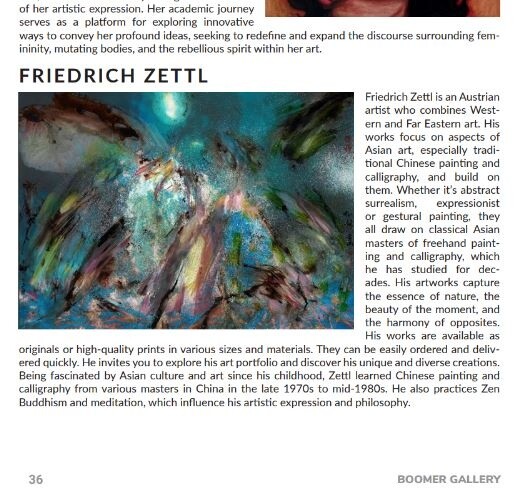
Artly Mix - Rua Pelotas - Vila Mariana, São Paulo - State of São Paulo, Brazil05/25 – 06/18 Exhibition title: Imaginarium Exhibition https://www.artlymix.com

Metaspacegallery https://metaspacegallery.com

Started May 25th 2024 ongoing. Exhibition title: Silence
All three galleries did a great job.
Imaginarium Exhibition
Artly Mix - Rua Pelotas - Vila Mariana, São Paulo - State of São Paulo, Brazil
Group Exhibition
25 May - 08 June 2024
Thu - Sat: 1 - 7pm
OPENING:
Sat 25 May 2024 - 4pm
Artly Mix - Cultural Space
Rua Pelotas 398, Vila Mariana
SAO PAULO - BRAZIL

Exhibition 'The Dark Side' in London
Boomer Gallery, Tooley Street, London, UK
As part of the thematic exhibition “The Dark Side” at the Boomer Gallery, London, 2 of my works will be exhibited.

Zen Calligraphy with Video
New Work Added: Zen in Calligraphy
I’m pleased to introduce Zen in Calligraphy, a new piece from my Painted Calligraphy series. This unique art form, which I developed, involves repeatedly writing Chinese texts—often poems—until a structure and vision gradually emerge. The work is the result of meticulously crafted calligraphy, combined with confident brushwork and ink techniques, where the subtle use of gray tones plays a key role.

This piece was created using hand-ground Chinese ink, allowing for the delicate interplay of fine gray tones. The result is an additional layer where the lightest grays merge seamlessly with the deepest blacks, adding depth and dimension to the work.
Throughout the calligraphy process, the focus was on remaining contemplative, avoiding any conceptual pursuit. The textures emerged naturally, reflecting the meditative approach. The short video provides insight into the creation of Zen in Calligraphy, showcasing each stage of the process and highlighting the final details.
youtube-video: https://www.youtube.com/watch?v=Yw16qu6aWcA
Bacopa Publishing House presents a video with my paintings of the underwater world. It is a compilation of works on a topic that I have particularly devoted myself to over the last 3 years.
Video featuring my Artwork related to Underwater
Video Featuring My Artwork for Bacopa Publishing
I’m excited to share that Bacopa Publishing has released a video showcasing my paintings of the underwater world. This video presents a collection of works I’ve been dedicated to for the past three years, exploring various aspects of the sea and diving through abstract and semi-abstract approaches.
Many of these pieces are deeply influenced by Asian philosophy, which plays a central role in my artistic process.
To fully enjoy the details of the artwork, I recommend watching the video on a PC.
https://www.youtube.com/watch?v=OTLPQKPnMS4
Black Zen – Painted Calligraphy
Black Zen. Today, I would like to present a work that is part of a series called “painted calligraphy”.
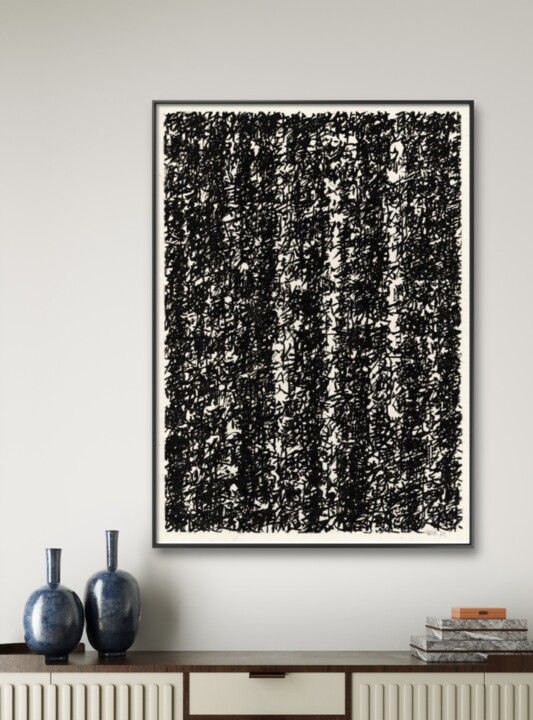
These contemporary works are inspired by traditional Chinese calligraphy and are philosophically influenced by the ideas of Zen Buddhism and Daoism.
In these works, old texts, mostly poems, are written over one another again and again in different ways to create a texture with artistic appeal or a poetic touch. Each character is written with the greatest care, and the rhythm is maintained to ensure the highest quality. Although the finished product may appear monotonous at first glance, it reveals secrets and invites you to meditate. Through disciplined precision when writing each individual character, an overall picture is created that is characterized by harmony, even if the work could initially be perceived as chaotic.
The Daoist aspect primarily involves playing with the opposites yin and yang. This achieves a result in which silence and noise are present at the same time as dynamism and calm, big and small or chaos and order.
Music plays an important role in the creation of these works. In this specific case, the work was performed to music by Giovanni Pierluigi da Palestrina.
This short video shows how the work was created [youtube-video]
About Zen Moments
About Zen Moments
Among the categories of Friedrich Zettl’s works on Artmajeur, Zen Moments hold particular significance.

Zen Philosophy and Art
Zen, a philosophy rooted in mindfulness and living in the present moment, originated in China and later profoundly influenced Japanese culture. Often associated with meditation and mindfulness practices, Zen helps individuals achieve inner peace and tranquility. This philosophy also extends into the realm of art, particularly painting.
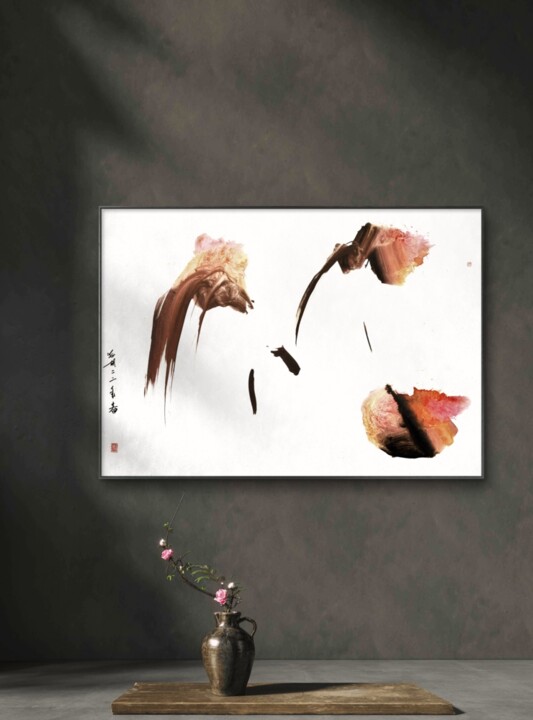
Zen Moment
Zen in Painting
Zen has had a lasting impact on Japanese painting, inspiring styles that emphasize simplicity, minimalism, and presence. Zen paintings are typically created using brush and ink, aiming to capture the essence of the subject rather than its detailed physical appearance. Common subjects include landscapes, animals, and elements of the natural world.
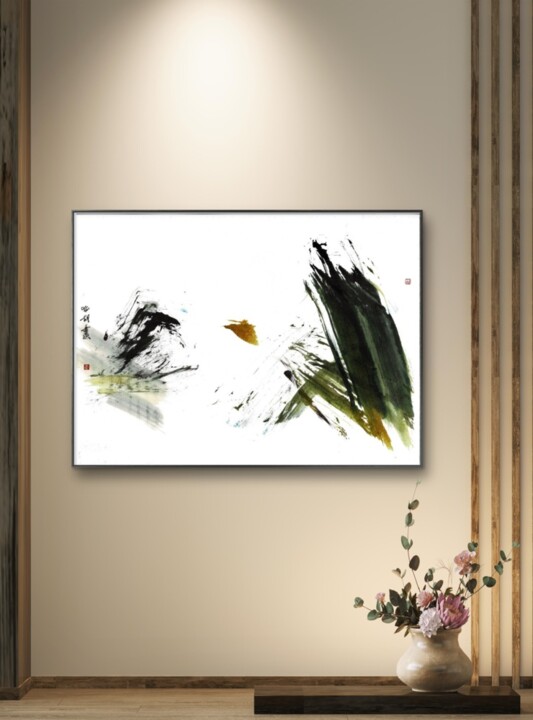
A Sound in the Silence
Hell O Wien - Halloween Short 2023
On the eve of Halloween 2023 I put together a short. It seems a bit dystopian, but that may have something to do with the globally tense times.
All portraits shown are based on 2 original works from the mid-1980s. They were recreated with graphic programs, one of which is AI-supported, and do justice to their new task of addressing Halloween.
Just as the living and the dead meet on Halloween evening, the graphics also show very realistic, lively elements and at the same time the destructive, ending thing - death.
Of course, it's fun that shouldn't be taken more seriously than Halloween itself.
Hello and Welcome!
Welcome to My Art Blog on Artmajeur!
I’m excited to welcome you to my blog here on Artmajeur, where I will share insights into my artistic journey and the philosophy behind my work. For the past three years, I’ve been showcasing my art online, primarily through my main blog at [zettl.blog](https://zettl.blog). I focus on exploring the connection between Asian painting, especially Chinese, and its philosophical roots. I aim to bring a similar depth to this platform, shedding light on both the artistic and technical aspects of Asian art, so you can better appreciate the works I offer.
In the Videos section, additional material complements my artwork, providing a deeper understanding of the process and thought behind each piece.
My Artistic Journey
I began painting in the late 1970s, initially influenced by surrealism and later by expressionism. In 1976, I started studying Sinology, alongside ethnology and art history. In 1979, after overcoming some initial challenges, I had the unique opportunity to study at the prestigious Central Academy of Fine Arts in Beijing, becoming the first European to do so after the Cultural Revolution. During my time there, I studied painting, calligraphy, and the art of seal carving, eventually writing my dissertation on Chinese freehand painting, a style deeply rooted in Daoist philosophy.
This form of painting can be seen as applied philosophy, with concepts like yin-yang playing a central role in shaping Chinese art. Though terms like "Zen" and "Tao" are often used loosely, I strive to present a traditional perspective, one that has remained unchanged for over a thousand years.
Through this blog, I will delve into the philosophical and technical aspects of my works, offering a deeper look into how these timeless ideas influence my art. If you ever have questions, feel free to reach out—I'm always happy to discuss these topics further.
Thank you for visiting, and I hope you enjoy exploring my work!
Warm regards,
Friedrich Zettl
 Friedrich Zettl with HE Ambassador Qi Mei.
Friedrich Zettl with HE Ambassador Qi Mei.
TV Portrait about Friedrich Zettl
Okto.tv, in collaboration with China Radio International, filmed a portrait of the painter Friedrich Zettl, which was broadcast on May 27, 2023 in Austria and shortly afterwards in China.
Zen paintings by Friedrich Zettl presented in virtual interior. Text in English.
Discover the unique art of Austrian artist Friedrich Zettl, who masterfully blends Zen Buddhism, Chinese painting, and calligraphy in his works. This video offers insight into his artistic background, techniques, and philosophy.
Zettl studied Sinology and spent several years at the Central Academy of Fine Arts in Beijing, where he learned traditional Chinese painting, calligraphy, and seal cutting from renowned masters. He was the first European admitted to the Academy after the Cultural Revolution. During this time, Zettl developed a deep connection to Daoism and Zen Buddhism, both of which profoundly shaped his artistic vision.
Working primarily on paper, Zettl uses fine inks and traditional Chinese ink, developing his own innovative methods that combine Western techniques with Asian philosophies. His brushwork and composition are deeply influenced by Chinese calligraphy, which he considers one of the highest art forms. For Zettl, Zen Buddhism represents the ultimate state of mind, and he strives to express this through his mastery of brush technique and personal growth.
Dao and Zen
portrait paintings from the early years










































